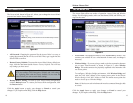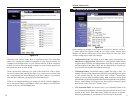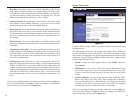
Wireless-G Access Point
2928
The SNMP screen allows you to customize the Simple Network Management
Protocol (SNMP) settings. SNMP is a popular network monitoring and man-
agement protocol.
The Identification settings let you designate the Contact, Device Name, and
Location information for the Access Point. The SNMP Community settings
allow names to be assigned to any SNMP communities that have been set up in
the network. You can define two different SNMP communities, with the default
names being Public and Private.
• SNMP. To enable the SNMP support feature, select Enable. Otherwise,
select Disable.
• Identification. In the Contact field, enter contact information for the
Access Point. In the Device Name field, enter the name of the Access Point.
In the Location field, specify the area or location where the Access Point
resides.
• SNMP Community. You may change the name from its default, Public.
Enter a new name in the Public field. Then configure the community's
access as either Read-Only or Read-Write.You may change the name from
its default, Private. Enter a new name in the Private field. Then configure
the community's access as either Read-Only or Read-Write.
When you’ve completed making any changes on this tab, click the Apply but-
ton to save those changes or Cancel to cancel your changes. For more infor-
mation on this tab, you can click the Help button.
• Basic Rate. The default value is set to Default. Depending on the wireless
mode you have selected, a default set of supported data rates will be select-
ed. The default setting will ensure maximum compatibility with all devices.
You may also choose to enable all data rates by selecting ALL. For com-
patibility with older Wireless-B devices, select 1-2Mbps.
• Antenna Selection. The default value is set to Diversity. In Diversity mode,
both antennas will be enabled. Otherwise, you can set to have wireless
transmission operate only on the Left or Right antenna.
• Beacon Interval. This value indicates the frequency interval of the beacon.
The default value is 100. Enter a value between 20 and 1000 milliseconds.
The Beacon Interval value indicates the frequency interval of the beacon. A
beacon is a packet broadcast by the Access Point to synchronize the wire-
less network.
• RTS Threshold. This value should remain at its default setting of 2346.
Should you encounter inconsistent data flow, only minor reductions are rec-
ommended.
• Fragmentation Threshold. This value specifies the maximum size for a
packet before data is fragmented into multiple packets. It should remain at
its default setting of 2346. A smaller setting means smaller packets, which
will create more packets for each transmission. Only minor reductions of
this value are recommended.
• DTIM Interval. The default value is 3. This value, between 1 and 255 mil-
liseconds, indicates the interval of the Delivery Traffic Indication Message
(DTIM). A DTIM field is a countdown field informing clients of the next
window for listening to broadcast and multicast messages. When the Access
Point has buffered broadcast or multicast messages for associated clients, it
sends the next DTIM with a DTIM Interval value. Access Point Clients
hear the beacons and awaken to receive the broadcast and multicast mes-
sages.
When you’ve completed making any changes on this tab, click the Apply but-
ton to save those changes or Cancel to cancel your changes. For more infor-
mation on this tab, you can click the Help button.
The SNMP Tab
Figure 6-14


















